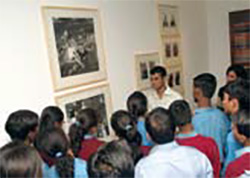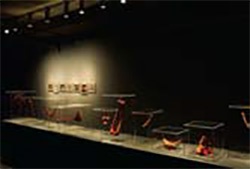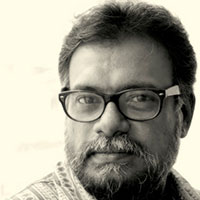Galleries are the places where a work of art is presented in a supposedly neutral context for aesthetic appreciation in tranquility. In this ideal/idealistic definition what we fail to recognize is the ideological role of the galleries and their premises that comes to play a major role in the production of meanings, values and paradigms of monetary exchanges. Taking a considerable amount of idealism out of the meaning of gallery as a space and as a structure for aesthetic appreciation/mediation would help us to understand the ideological roles played by the galleries in any given context of aesthetic production.
Ideology, seen in a positive light, is a set of codified values and practices that unifies the people towards a progressive future. But seen in the context of discourse on the systems of socio-political, economic and cultural power the word ideology comes to have debilitating connotations. Ideology, hence is understood as a set of codified values both in the real and virtual spaces, public and private realms, that regulate the behavioral patterns and choices of the people and curb them of their innate ability to discern good from the bad. Ideological positioning (of anything), in this sense, is a claiming of position within the systems of power and exercising of it towards personal/vested gains.

In this essay, I would like to analyze how certain galleries operating from Delhi and Mumbai position themselves within the discourse of ideology as a power wielding system and regulate aesthetic choices of the people in general and that of the regular art lovers in particular. My curiosity also takes me to see how some of these galleries deliberately shift their position from being benefactors of art to the players in an ideological game that brings in better yield during the favorable economic situations. However, I do not overlook the fact that any art gallery, even when it has a proclaimed position of being a benevolent gallery, while functioning within the given economic conditions and climes, does not shy away from being ‘commercial’ in its true sense.
The above statement sets up a general backdrop for my enquiry into the ideological positioning of Indian galleries. Seen against this backdrop, we have to accept that with no considerable monetary support for art from the public/government agencies, artists are expected to work with these galleries, hence are expected to accept the commercial interests of these galleries. This results into a situation where both the galleries and artists come to have an agreement upon the commercial/economic gains that their potential collaboration would yield. What I mean to say is this; galleries are commercial places unless their activities are supported by public/ private funds, which are expected to be spent in order to fulfill ‘cultural responsibilities’.
Galleries are commercial in nature and any art activity happening within these galleries is a commercial act- let’s accept this simple and commonsensical logic. When a gallery presents a set of works by an artist or a group of artists, it understandably involves the artists also within its commercial strategies. Now the question is, what is the logic of a gallery or a group of galleries in selecting the artists? How do they arrive on the conclusion that their artists are the best ‘available’ in a given art scene? What are the tools/mediums that these galleries use in order to select their artists? Once you find answer to these questions, you will come to know how the manipulative ideologies play a strong role in the selection of works of art and the artists.

My referential time frame is last fifteen years, during which the galleries became ‘professional’ with special agendas. Vadehra Art Gallery, New Delhi, with its reputation as a ‘gallery of masters’ partly diverted its attention to the young contemporaries by the new millennium as the directors of this gallery could foresee that the future was going to belong to the contemporaries. They showcase a lot of young contemporaries today with well-produced catalogues and lavish openings. This shift in position is underlined with the establishment of the FICA (Foundation for Indian Contemporary Art) and also by the institution of the FICA Awards.
Though awards are not a new thing in the contemporary Indian art scene the FICA Award makes a lot of difference in giving recognition to the young artists. Before the FICA Award, there used to be the Bodhi Award, the Art India, the India Habitat Centre Award and the Kashi Award. If you look at the pattern of the selection of awardees by these agencies, you would notice, how the same set of artists are awarded simultaneously or in the successive years. At times, it is the same panel that selects the same awardees. The ideological underpinning of these selections is quite palpable. They together create an impression that the ‘given’ artists, who are expected to work with the ‘giving’ agencies at least for a show, are the ‘best’ artists at a given time frame.
The selection of the ‘best’ is quite relative. It is dependent on the number of applicants and the presentation of works through applications. One award given to a minimum of three artists also presupposes the exclusion of other artists from being considered for other awards for the virtual fear of the successive panel members falling short of the ‘quality’ of another panel that has already selected those three artists. This pressure of a presumed idea becomes an ideological pressure on the panelists, which in turn results into the endorsement of the same artists, whose potential to yield better profits will be tapped later by the instituting galleries. Hence, the primary declaration of an award becomes an ideological tool by the concerned gallery to exercise influence on the future judgment of the other galleries.

Why I say the FICA Award, like the IFA (Indian Foundation for Arts, Bangalore) has a different ideology than that of the other awards, is because the FICA is not a gallery. It is a foundation for the contemporary arts in India. So the institutional complexion is fundamentally different from that of the awards instituted by the galleries. However, unlike the IFA awards, the FICA award has an ideological agenda. When seen attached to its parental organization, that is the Vadehra Gallery, the FICA Award, in a way, sets up a parameter for and by its parental gallery and the awardees’ quality would naturally reflects the already established ‘quality’ of Vadehra Gallery. In this way, Vadehra exercises a stronger power on the future selection process of the artists by other galleries. In the coming days, many galleries would turn their attention to the North Eastern art scene thanks to the FICA Award given to one of the artists from the North Eastern region.
Analyzing art awards vis-à-vis the FICA Award is not an attempt to implicate any agency of misguiding people. On the contrary, my effort is to emphasize how a gallery’s shift in position (directly or indirectly) would make many like-minded galleries to follow the suit. Speaking on a different note, I would like to see how a similar shift in position happened amongst the Indian galleries during the first five years of the new millennium. During the 1990s, the Mumbai based galleries like Sakshi Gallery, Chemould Gallery and so on were doing shows with the young contemporaries. The artists were really young or many of them were fresh from the colleges. Most of the other galleries in India were still working with the modern masters at that time. It was Nature Morte’s Peter Nagy who aggressively started bringing the young contemporaries from Mumbai to Delhi. Gallerists like Prima Kurien also did considerable job in doing so. But the other galleries were not there to listen.
But when it comes to the art market boom, we see how all those galleries, that were averse to show the young contemporaries were frantically looking for the same artists. This shift in position was facilitated by the market on the one hand, and on the other through the potential collaboration between the galleries. Once the domestic and the foreign markets opened up for the Indian contemporary art, these erstwhile benefactors of contemporary art came around together for curtailing the inter-gallery movements of the artists. This heralds the beginning of the ideological positioning of the galleries in order to reap better commercial results.

Once ideologically positioned together and made considerable and amicable business deal amongst them, these galleries became the ideological arbitrators of taste and value. As the pioneers in the promotion of young contemporaries, these galleries (exclusions and inclusions are the prerogative of those people who are familiar with the Indian gallery scene) could ideologically hold the position of being the selectors, exhibitors and arbitrators of the ‘new’ art. The India Art Summit II (New Delhi, August 2009) was the supreme example of such ideological arbitration as more than three galleries in a row exhibited the works of the same artists, thereby underlining their business and ideological allegiance before a larger audience (including the foreign delegates).
Perpetuation of this ideological arbitration and insistence could be seen in the establishment of Devi Art Foundation. I choose to speak about Devi Art Foundation because, whether the founders of this museum want it or not, it does have the reputation as the arbitrator of the ‘new’ taste, more than any other contemporary museums in India have today. The ideological positioning of the Devi Art Foundation and the overt allegiance of certain galleries with it have brought in such a situation that what is not accepted amongst this circuit becomes absolutely ‘outdated’.
I am not here to implicate the Devi Art Foundation for creating an ideologically charged aesthetic situation in the contemporary art scene in India. Instead, I would like to see how the founders of the Devi Art Foundation blur their own aesthetic preferences by carefully positioning their museum as the best available museum for ‘cutting edge art’. It has been said that the founders of the Devi Art Foundation started off their art collection with the modern masters and the young contemporaries. From there they moved on to the bizarre to cutting edge and new media art. I am not aware whether the Devi Art Foundation has offloaded its modern, post-modern and contemporary stuff while showcasing its cutting-edge art for the public.
This peculiar situation, in which the personal or collective ideology of the gallerists (this could be extended to the buyers, collectors, dealers, art lovers, art critics, curators, general art lovers depending on their capacity to wield or yield power) gets blurred in the public realm is a worth analyzing situation. This blurring could be conscious on the one hand and on the other it could be an inevitability thanks to the reasons of name, fame and fortune. However, I feel that there is some sort of deliberation in the choice of a public face for the museum or gallery, where this blurring of ideology is consciously acted out. I believe it is the case of art galleries like Gallery 320, New Delhi and many new galleries in Delhi or elsewhere. They all deliberately blur their ideological stance vis-à-vis their taste and collection and create a ‘public face’ for ‘public consumption’, which could deceive the unsuspecting viewer.
Some gallerists do a lot of balancing act in order to maintain their position as cutting-edge gallerists, while retaining their original position as commercial gallerists. This balancing act could be with grace and élan or with confusion and panic. Shalini Sawhney of the Guild Gallery, Mumbai is one gallerist, who does the balancing act with a lot of skill. Sawhney, while retaining her original position as a commercial gallerist, tries out her hand at the cutting-edge and new media art by employing young curators. The founders of Mirchandani+Steinruecke Gallery also do this act with finesse. Sakshi Gallery is a worth mentioning name in this context because of its dexterous journeys between the ‘conventional’ and the ‘cutting-edge’ art.
Before closing this debate, I would like to mention the latest fad in the Indian gallery scene. Hip and cool in their presentations, magnificent and iconoclastic in their approach, these galleries, namely Maskara Gallery and Volte (both in Mumbai), to use a different jargon, ‘defy the law of gravity’ and present their shows. Though the kind of art presented in these galleries do not find their way directly into collections, these gallerists put up a brave face and do their shows in regular intervals. The funds that support these shows are quite obscure and the programs that they device show no chances of breaking even. I have found certain works from the Maskara Gallery going into the Saatchi Collection in London. But such odd happenings do not fundamentally sustain the ideological posturing of these galleries.
Both the Volte and Maskara Gallery are ideological in nature as they are able to control and regulate the taste of those ‘young’ people who are ready let themselves be influenced by the parameters set up by these galleries. However, unless these galleries prove themselves to be commercially viable, through ideological manipulations they would be misguiding a set of artists, curators, collectors and so on towards a no win situation, where ultimately the artists are left to suffer alone. I don’t have any clue about the nature of their funding techniques. Until they come out with a clear picture on their commercial viability, their position would be that of an experimental-residency space and a cutting edge temporary museum.














